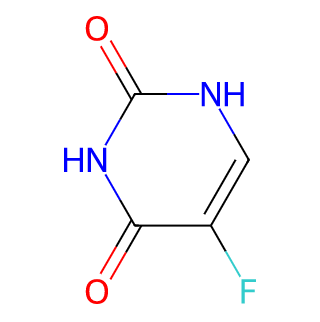- Synthetic anti-infective drugs
- Medications for the digestive system
- Antipyretic and analgesic drugs
- Medications for the blood system
- Medications for the respiratory system
- Anti-allergic drugs
- Medications for the urinary system
- Diagnostic medications
- Immunosuppressive and immunomodulatory drugs
- Vitamins and mineral supplements
- Antioxidants and medications for osteoporosis
- Antiparasitic drugs
- Ophthalmic medications
- Amino acids and their derivatives
- Dermatological medications
- Medications for the circulatory system
- Antitumor drugs
- Medications for the nervous system
- Hormonal and endocrine function-regulating drugs
- Antibiotics
- Others
CAS Number: 51-21-8




Basic Information
Product Name: 5-Fluorouracil
Synonyms: 5-FU; 5-Fluoracil; 5-Fluoro-2,4(1H,3H)-pyrimidinedione
CAS Number: 51-21-8
Chemical Formula: C4H3FN2O2
Molecular Weight: 130.08 g/mol
Physical Properties
Appearance: White or off-white crystalline powder
Melting Point: 281-286 °C (decomposition)
Boiling Point: 190-200 °C at 0.1 mmHg
Density: 1.4593 g/cm³ (estimated)
Solubility: Slightly soluble in water, slightly soluble in ethanol, insoluble in chloroform; soluble in diluted hydrochloric acid or sodium hydroxide solutions.
Chemical Properties
Stability: Stable. Light-sensitive. Combustible. Incompatible with strong oxidants and strong bases.
pH Value: 4.3-5.3 (10g/l, H2O, 20°C)
Refractive Index: 1.542
Biological Activity
Mechanism of Action: 5-Fluorouracil is a DNA/RNA synthesis inhibitor that irreversibly inhibits thymidylate synthase (TS), interfering with nucleotide synthesis. It also converts to active metabolites FUTP and FdUTP, inducing RNA and DNA damage, respectively.
Cell Cycle Effects: It primarily acts on cells in the S phase of the cell cycle but also has effects on cells in other phases.
Antitumor Activity: 5-Fluorouracil has been used to treat various cancers, such as colon cancer, breast cancer, and head and neck cancer. It enhances the antitumor activity when combined with thymidine.
Applications
Therapeutic Use: As an antineoplastic agent, 5-Fluorouracil is used in the treatment of multiple cancers, including gastric cancer, rectal cancer, breast cancer, ovarian cancer, and liver cancer.
Research Use: It is also used in scientific research for studying its mechanisms of action, antitumor activity, and interactions with other drugs.

Tai Yau Street, San Po Kong, Kowloon, Hong Kong, China.



